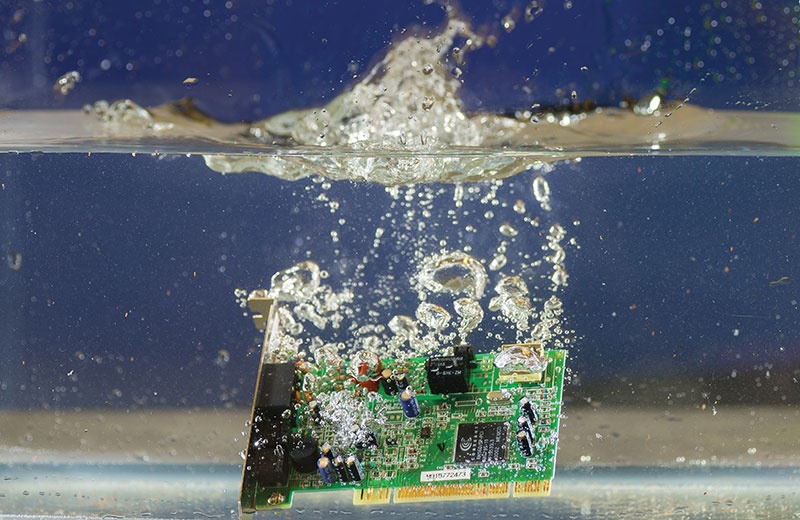Reliability Needs to be Designed-In from the Lowest Level

Cutting-edge technology demands more care to ensure reliability and resilience.
Human nature is to invent, to create technological solutions to the challenges and problems we see. We are increasingly dependent on high-technology solutions as we address more complex issues. Some of these issues are of our own making. Others arise from our increasing expectations: what we want to do, where we want to go, how safe we want to feel.
All this keeps the electronics industry extremely busy. And the equipment we create – remote smart sensors, street-level broadband infrastructure, full-color digital signage, supercomputers on wheels (or wings) – is more and more likely to be required to operate faultlessly in extreme environmental conditions. Gone is the era when advanced electronics assemblies were mostly destined to spend their lives in air-conditioned telecom offices or otherwise benign environments. Now, they are out in the cold. And the heat. And the humidity. And this presents a major reliability challenge that needs to be addressed at every level from the installation and the enclosure down to the substrate.

Figure 1. Properties of substrate materials can be liable to change with exposure to environmental factors such as moisture.
The effects on components caused by environmental factors such as high ambient temperatures and humidity can be obvious, often manifested as surface oxidation, corrosion, or mechanical distortion. Excessive heat can quickly dry wet electrolytic capacitors, which consequently lose their capacitance over time. The properties of substrate materials also can be liable to change with exposure to environmental factors such as moisture, as well as due to general aging. Substrates exposed to excessive humidity can absorb moisture, which increases the dissipation factor (Df), leading to more lossy behavior that saps signal energy.
Conductive anodic filament (CAF) formation is another phenomenon that gets attention within the industry, although we still have lengths to go to address the issue rigorously and properly. Still often considered a material issue, CAF performance is known to be influenced by design and process, in addition to temperature, humidity and bias. Pathways are also essential for CAF progression. As package I/O pitches continue to shrink, and component placement density continues to increase, these trends are moving against efforts to maximize reliability.
Initial observations of CAF were restricted to laboratory testing. Now, however, we are pushing equipment containing extremely densely populated boards into the field, and it needs to stand up to the environment. Recent trends in e-mobility have also moved CAF performance requirements from tens of volts to thousands of volts, bringing very real challenges in test design and equipment use.
Another modern trend is a large proportion of remotely installed equipment can be considered mission-critical. So many of us are dependent on mobile and Internet-based services to work, do our banking, authenticate our identities, and host our wallets and travel credentials, such as train tickets and aircraft boarding passes, that our world would grind to a halt if we couldn’t rely on the infrastructure and sensors distributed liberally throughout the places we go. And this is without mentioning our reliance on automotive safety features and the roadside and trackside technology that support services such as signage and signaling. Looking ahead to when 5G becomes part of the mix of technologies involved in directing autonomous vehicles and remotely managing industrial automation, its capacity for massive machine-type communications (mMTC) and ultra-low-latency communications (ULLC) must come with assured reliability.
In addition, despite clear economic arguments for standardizing hardware across multiple product lines, addressing different applications and different markets, design teams should assess whether an assembly will be reliable when taken out of one context and placed in another. There is an increased tendency to create software-defined products based on a common hardware platform. While this can allow flexibility to address the needs of different markets, hardware must be designed to withstand the harshest conditions it is likely to encounter in any location it may be used. We need to be careful not to send assemblies into environments they were not designed for, in the interests of ease or financial expediency. Recall early failed attempts to migrate low-cost consumer electronics hardware to the automotive environment.
It may be relatively unexciting compared to the science-fiction lifestyles we can foresee coming within our reach. However, reliability is an issue that urgently needs to be addressed. To continue packing more components onto boards, with increasingly high-density interconnects, and continue adding features and raising system capabilities, reliability needs to be designed in from the lowest level – the properties of the substrate material – upwards.
Materials suppliers should be careful to ensure new products are tested fully. This must include properly assessing long-term reliability, such as through thermal aging tests. This can be especially important with high-performance materials, as board designers seek increasingly fast data signals and RF circuits operating up to mm-wave frequencies.
On the other hand, reliability is a challenge for everyone in the industry to address. Resistance to deterioration can be designed in through astute circuit design, ingress protection and establishing appropriate installation protocols that are also simple and straightforward for field teams to observe. None of these alone solves the entire problem. Applied in combination, however, it should be possible to create reliable, high-performing equipment for deployment in remote and challenging environments.
is technology ambassador at Ventec International Group (ventec-group.com); This email address is being protected from spambots. You need JavaScript enabled to view it..




